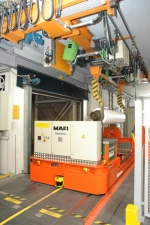德国MAFI 工业重型自动导向车(AGV)
品牌:德国MAFI
产品详情
产品参数
产品图片
Try transporting a reel of paper weighting 5 tons and a diameter of 2 m over a distance of 120 m in an old factory building every 40 minutes. This apparently simple-sounding transport task was placed on the specialists at MAFI in Tauberbischofsheim by the paper mill Scheufelen GmbH + Co. KG in Lenningen near Kirchheim/Teck and its workforce of 800. What sounded so simple turned out to be very complicated.
The AGV vehicle had to be integrated into the existing infrastructure. The 2.7-m long reels of fine paper coming from paper machine II are transported by industrial lift to the third floor where the finishing systems are installed. Once there the roll is unloaded by an automatic crane onto the AGV – a control engineering challenge, as the AGV must be perfectly harmonised with the crane controller and positioned with an accuracy of ± 2 mm.
But that is not enough. Beside the unloading station there is a frequently used training and presentation room – and yes you have guessed it, the corridor to this information centre is shared by the visitors and the AGV. Due to the lack of space it is not possible to separate the transport route and the people walking. So the vehicle is only allowed to be driven at 2 km/h and it must continuously warn of its presence with acoustic and visual warnings. Having only just tackled this hurdle, the vehicle of type AGV 15 T must pass along a narrow corridor that cannot be used simultaneously by the AGV and people walking. The S-bend in the middle of this section places very high requirements on the all-wheel steering – depending on the curve segment, diagonal or conventional movement with all-wheel steering is used. After the bend the vehicle accelerates back to 2 km/h and moves to the transfer point where the reels are unloaded by a manually operated crane.
The specialists selected optical guidance with a scanner. Equipped in this manner the vehicle can operate at up to 4 km/h. The braking distance is only 28 cm thanks to the reduced speed. Three of the four wheels, equipped with wear-resistant Vulkollan tyres, are driven – all are power steered. The wheels had to be designed as double rollers due to the low floor pressure required. An rf data link to the automatic crane system was integrated as were charging contacts. The electrolyte battery (125 Ah/24) is recharged in a few minutes when the vehicle is in the end position at the automatic crane. During a movement cycle a maximum of 25 % of the battery capacity is drawn – there are therefore reserves for a possible increase in cycle frequencies.


